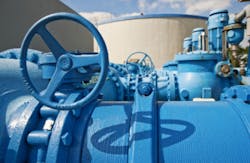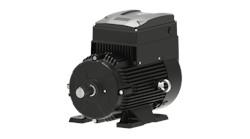Editor’s note: This is part two of Water Technology’s April feature titled, "Centrifugal pumps and their piping for water applications." In Part one, the author discussed pump design and components, performance and rotordynamics. If you missed Part one, please visit WaterTechOnline.com to read the article in its entirety.
The function of suction piping is to supply an evenly distributed flow of water to the pump suction, with sufficient pressure to the pump to avoid excessive turbulence in the pump impeller. Pump suction problems can result in poor pump performance, poor bearing life and poor mechanical seal performance. In extreme cases vibration can cause failure of piping and appurtenances. Significant causes of poor pump performance and maintenance problems are cavitation and air-lock. Suction piping should be adequately sized and properly designed to avoid cavitation. Generally for any pump’s piping, the optimum piping size should consider the installed cost of the piping and the operational requirements (piping friction and others).
There are always some maximum velocity limits. Particularly for suction piping, the piping size should limit velocity to values below those where bubbles will rise through water. A minimum velocity is usually needed to prevent the settling of solids (if applicable). As a very rough indication, suction piping velocities should be in the 2.95 feet to 4.27 feet per second range unless suction conditions are unusually good. In many pumps, suction piping is at least one size larger than the suction flange at the pump. The piping should also be laid out correctly to eliminate air/gas pockets and air-lock. The suction piping should be as short as possible and as simple as possible to prevent accumulation of air from water being pumped. In other words, suction pipes need to be short and straight. The suction piping should be arranged with as few bends as possible. If bends are necessary, use long radius ones when possible. An important factor to consider during design of suction pipe work geometry is to reduce turbulence at the pump suction nozzle.
It is imperative that the amount of turbulence and entrained gas (or air) is kept to a minimum. The water flow is further complicated when elbows or tees are located adjacent to the pump suction nozzle; when this happens, uneven flow patterns or air (gas) separation keep the water from evenly filling the impeller. A straight length of pipe is needed before any pump. As a rough indication, a straight length of pipe of an equivalent length of five times the pump inlet size (five times diameter) should be installed before any pump; some specifications mandate eight times diameter or even 10 times diameter for this straight length. With a suction line entering the pump in the horizontal plane, the eccentric reducer is placed with the flat on the top.
Both a check valve and a manual stop valve (usually gate valve) should be installed in the discharge piping with the check valve placed between the pump and the stop valve to protect the pump from reverse flow and excessive back pressure. If a control valve is needed, place at the discharge piping in a reasonable distance from the pump. Ideally, the optimum control valve location is within 4.93 feet of the pump discharge to prevent too much surging of water in the pumping system when the discharge is throttled.
Avoid pockets or high points where gas (air) can accumulate in the suction and discharge piping. An ideal discharge piping run is one where the piping gradually slopes up from the pump to the discharge. This will ensure any gas or air in the discharge side of the pump can be evacuated to the outlet.
Radial forces are being generated in the pump housing from the pressure in the piping system acting on the volute area. The magnitude and direction of the forces is dependent upon the piping arrangement along with the areas and pressures involved; this should be considered in the design of pump piping. For maintenance and repair work, remove the coupling; the pump internals can also be removed from the pump case, ideally without disturbing the pump’s piping.
Site installation and operation
The pump installation requires special attention. The pump base-plate should be leveled (side-to-side, end-to-end, etc.) to within 0.008 inches per inch; for example, less than 0.04 centimeters for a 78.8-inch pump base-plate. Regarding the installation of a pump’s piping, it is recommended to pipe from the pump suction flange to the suction source (such the pipe rack), not the other way around.
Do not operate a centrifugal pump for long periods of time at or near the shut-off point (zero flow maximum head). For some pumps, this operation should be limited to 20 to 100 seconds. In certain simple pumping systems, the pressure switch shuts the pump down when the pressure is high, which means there is low or no flow. Use more sophisticated measures and controls for other pumping systems to avoid operation at or around the shut-off point.
Any centrifugal pump should have a pressure gauge on the discharge side close to the outlet of the pump; this will help diagnose pump system problems. It is also useful to have a pressure gauge on the suction side. Many pumps do not have it, but this pressure gauge could be of great help in some circumstances. The difference in pressure is proportional to the total head. The pressure gauge reading will have to be corrected for elevation since the reference plane for total head calculation is usually the suction flange of the pump.
In case of any issue or problem, an accurate suction and discharge pressure reading should be taken. Additionally, check the pump for excessive vibration, noise, bearing operation, shaft deflection, operating temperature and other operational details. If pump hydraulic operation seems normal, a problem source could be "alignment," "bearing" or "seal."
Most centrifugal pumps cannot run dry, the pump should always be full of water. To ensure a pump stays full of water, occasionally a check valve at the suction piping is needed (for instance, a foot valve in some water sources at the source end of suction line). Certain types of centrifugal pumps do not require a check valve at suction, as they can generate suction at the pump inlet to lift the fluid into the pump — some of them are known as self-priming pumps.
Centrifugal pumps should preferably be self-priming. Many plants and pumping services have successfully converted to self-priming pumps for different water applications. Self-priming pumps should usually be the first choice. For many centrifugal pumps, the height and size of suction piping have been too large for self-priming pumps. Sometimes a special pumping system design can be selected to achieve a self-priming capability — for instance, a below ground pit eventually can be built to allow the pump to be lowered.
When gas (air) enters a pump it can get trapped in the volute, reducing the capacity and creating vibration and noise. If a pump is excessively noisy, most likely gas (air) in the pump creates vibration and noise. A less common issue could be cavitation. Cavitation usually produces a distinct noise, often different from noise produced by other reasons. Another way to examine if the issue is cavitation is to monitor fluctuations in suction and discharge pressure.
Operation at lower or higher than BEP (best efficiency point) flow rate results in lower efficiency, poor performance, higher bearing loads, increased shaft deflection and seal problems. Particular attention is required for low flow rates. Most centrifugal pumps should not be used at a flow rate less than a certain level (say as a very rough indication 50 percent of the flow rate at BEP) without a recirculation line. The factors determining the minimum allowable rate of flow include the following:
- Temperature rise of water: This is often established as 46.4° F or 50° F; if a pump operates at very low flow (say around shut-off), it could overheat.
- Radial hydraulic thrust on impellers: This is most serious with single volute pumps, and even at flow rates as high as 50 percent of BEP could cause reduced bearing life, excessive shaft deflection, seal failures, impeller rubbing and shaft breakage.
- Flow recirculation in the pump impeller: This can also occur below minimum flow (say 50 percent of BEP) causing noise, vibration, cavitation and mechanical damage. Recirculation can occur at both impeller inlet and outlet.
- Total head characteristic curve: Some pump curves droop toward shut-off and other curves show a dip in the curve. Operation in such regions should be avoided.
If a lower flow rate is needed, a recirculation line or another capacity control method, such as a variable speed driver, should be used. Operation at high flow could also be problematic. The maximum flow point can often represent the theoretical operating limit and the pump may not operate past this point, will be noisy and vibrate excessively as well as consume the maximum amount of power.
Pump monitoring and inspection should receive attention for a successful operation. In addition to measuring running clearances, check wear parts for eccentricity, out of roundness and corrosion.
Amin Almasi is a rotating machine consultant in Australia. He is a chartered professional engineer of Engineers Australia (MIEAust CPEng – Mechanical) and IMechE (CEng MIMechE) in addition to a M.Sc. and B.Sc. in mechanical engineering and RPEQ (Registered Professional Engineer in Queensland). He specializes in rotating machines including compressors, gas turbines, steam turbines, engines, pumps, condition monitoring and reliability. Almasi is an active member of Engineers Australia, IMechE, ASME and SPE. He has authored more than 100 papers and articles dealing with rotating equipment, condition monitoring and reliability.


